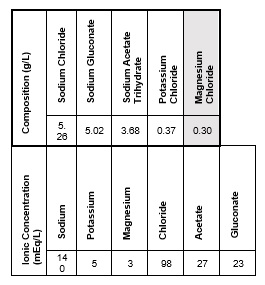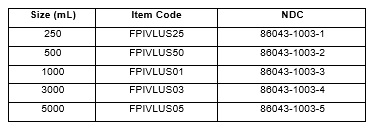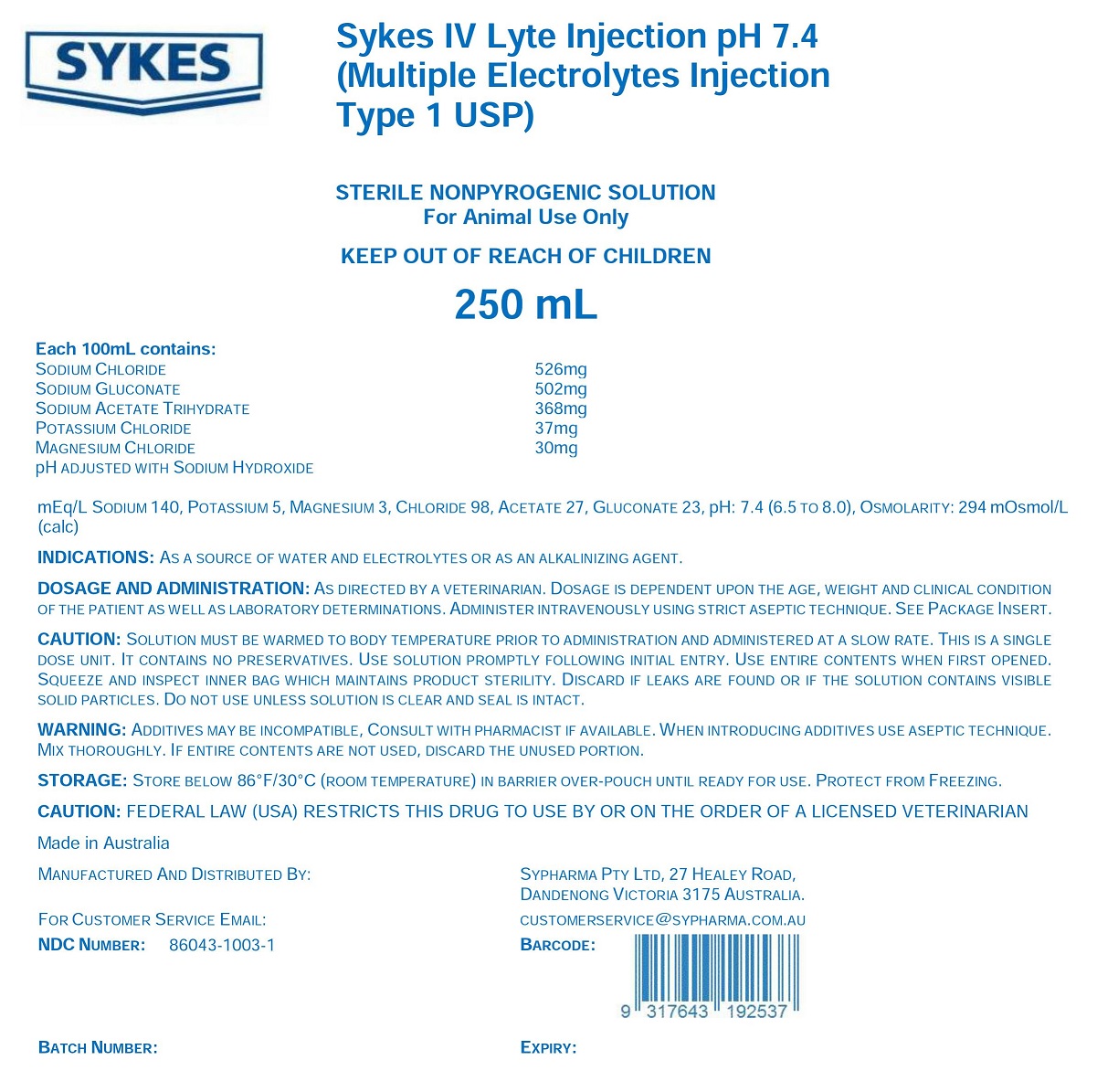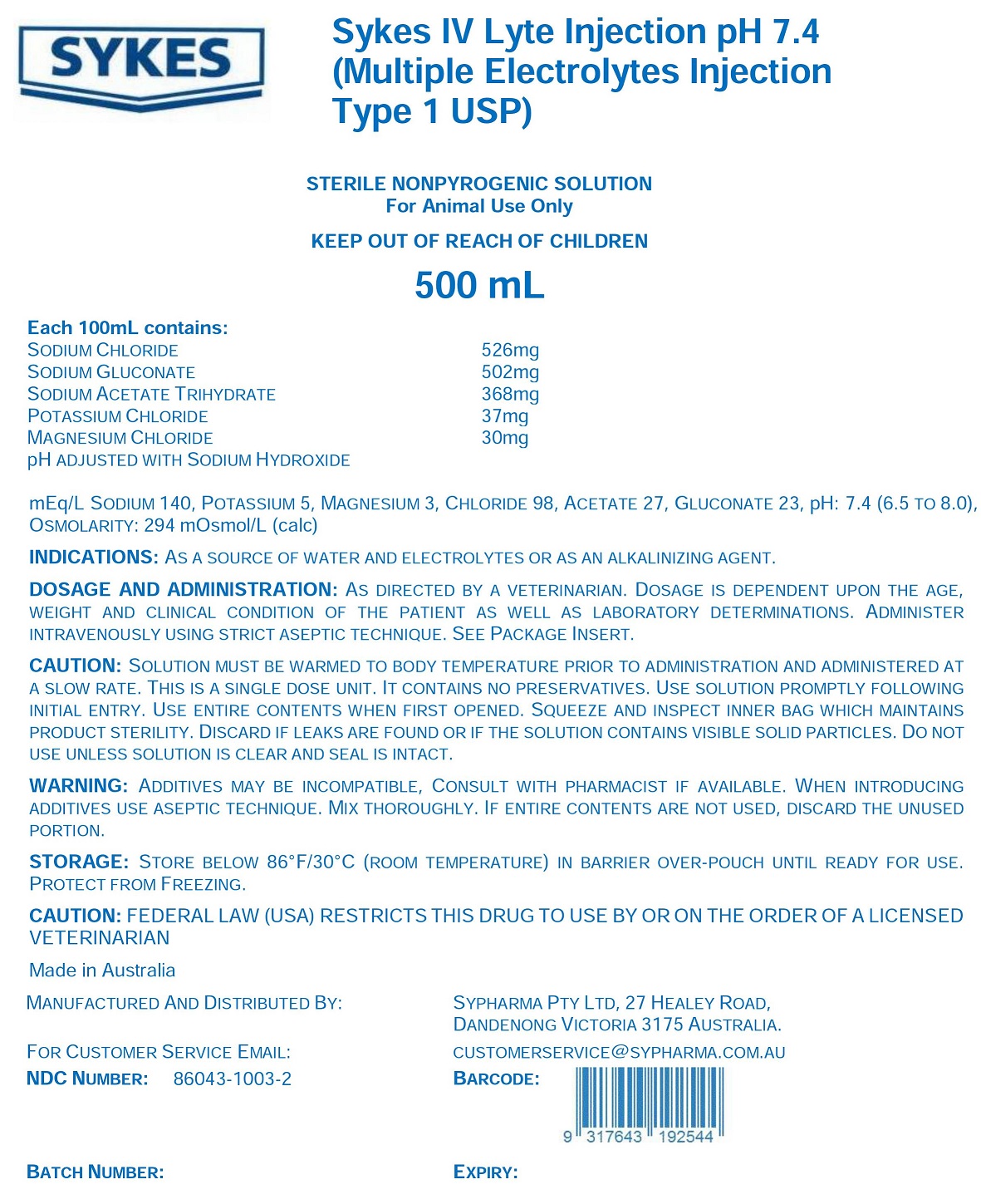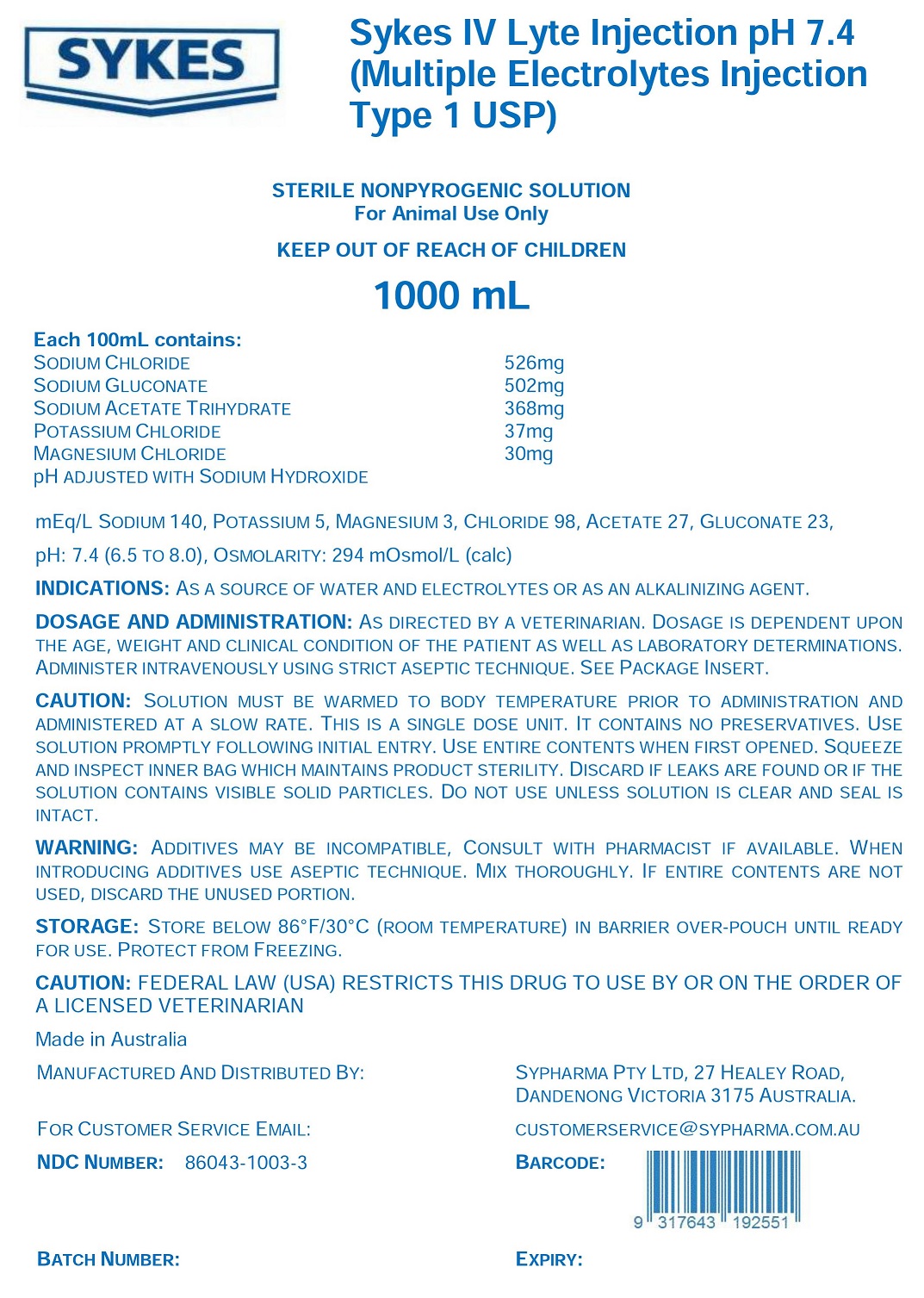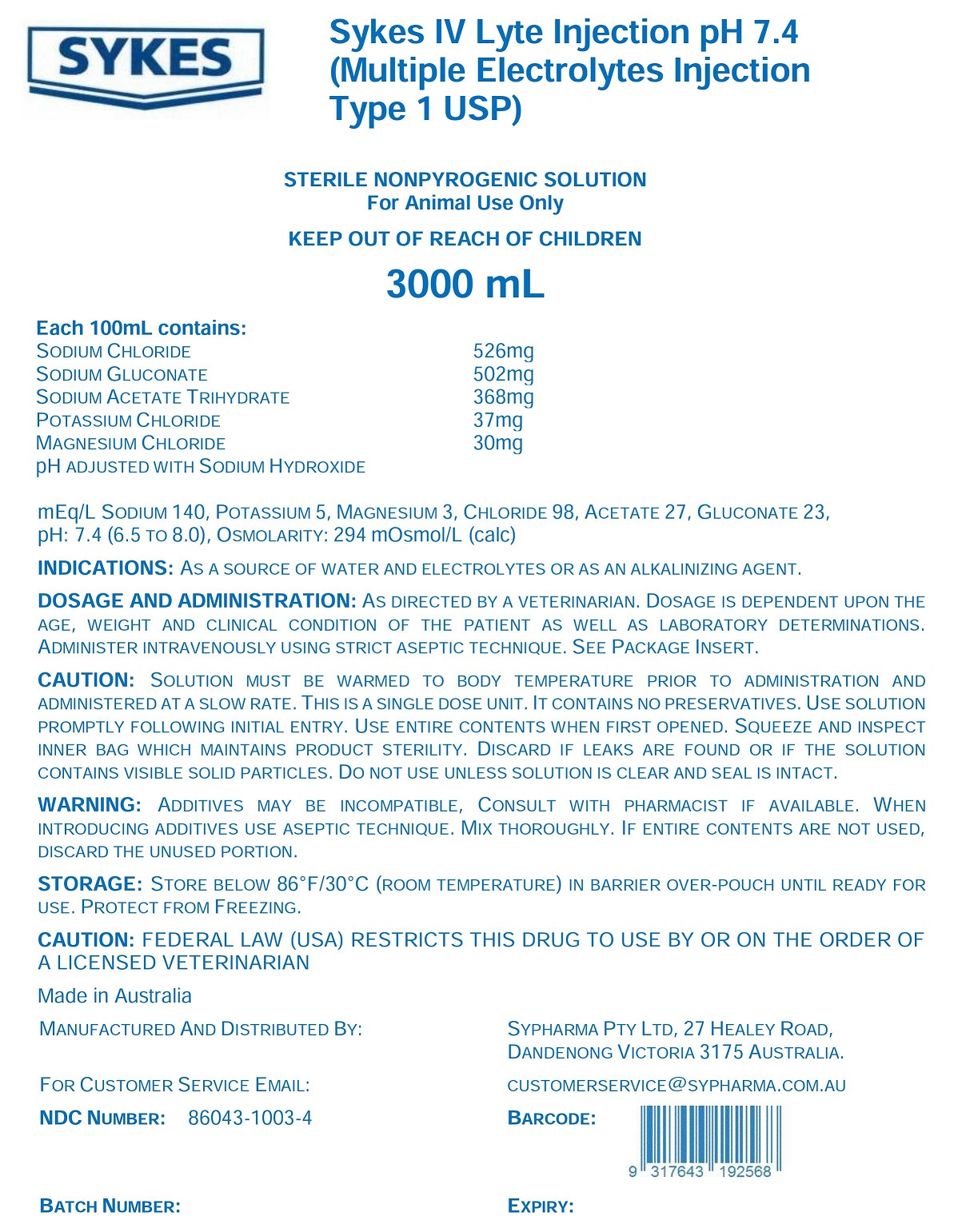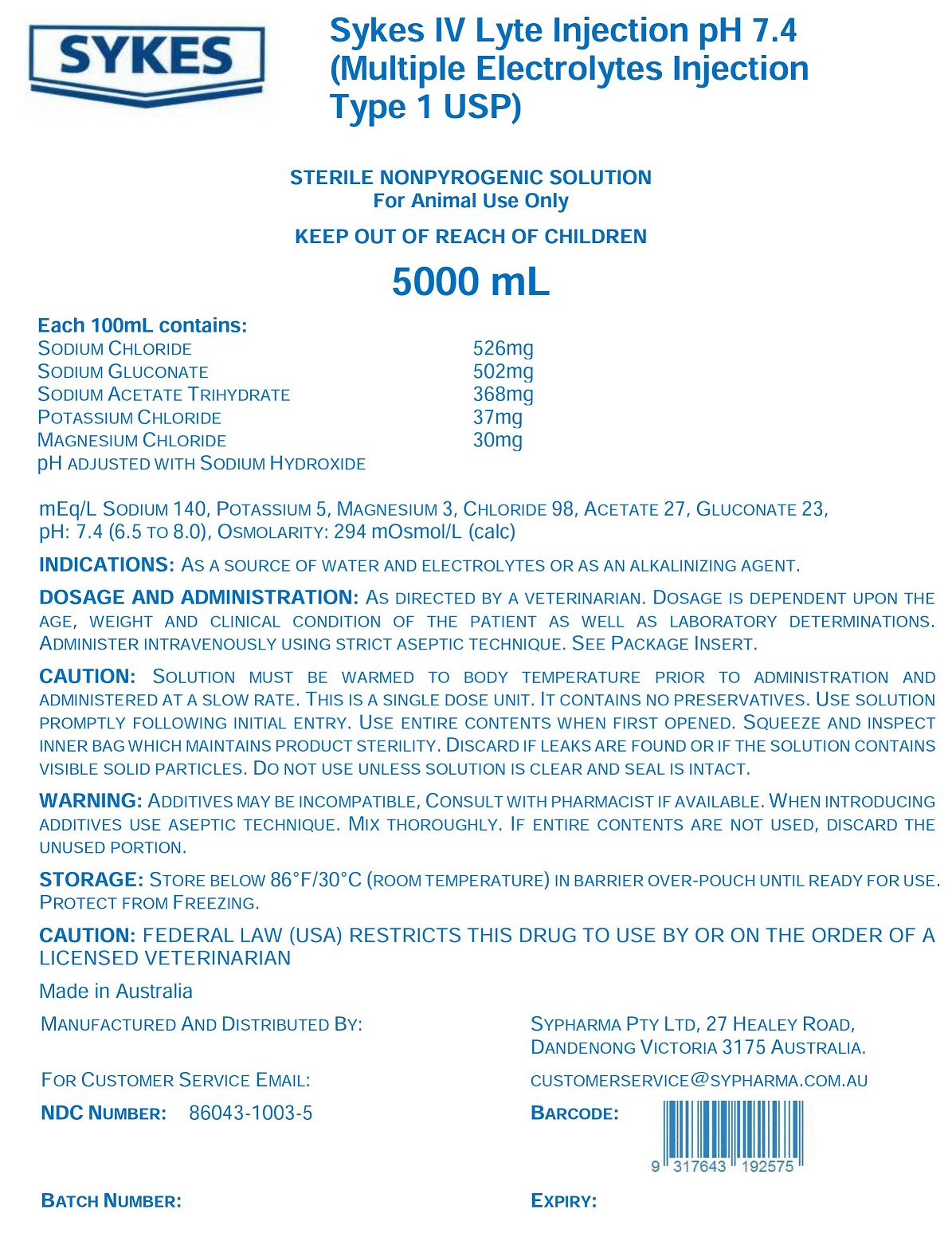Animal NDC 86043-1003-2 Sykes Iv Lyte
Sodium Chloride, Sodium Gluconate, Sodium Acetate, Potassium Chloride, Magnesium Chloride Injection
Animal Product Information
| Field Name | Field Value |
|---|---|
| Animal NDC Code | 86043-1003-2 |
| Proprietary Name | Sykes Iv Lyte What is the Proprietary Name? The proprietary name also known as the trade name is the name of the product chosen by the medication labeler for marketing purposes. |
| Non-Proprietary Name | Sodium Chloride, Sodium Gluconate, Sodium Acetate, Potassium Chloride, Magnesium Chloride Injection What is the Non-Proprietary Name? The non-proprietary name is sometimes called the generic name. The generic name usually includes the active ingredient(s) of the product. |
| Labeler Name | Sypharma Pty Ltd |
| Product Type | Prescription Animal Drug |
| Usage Information |
|
| Active Ingredient(s) |
|
| Inactive Ingredient(s) |
|
| Marketing Category | UNAPPROVED DRUG OTHER What is the Marketing Category? Product types are broken down into several potential Marketing Categories, such as NDA/ANDA/BLA, OTC Monograph, or Unapproved Drug. One and only one Marketing Category may be chosen for a product, not all marketing categories are available to all product types. Currently, only final marketed product categories are included. The complete list of codes and translations can be found at www.fda.gov/edrls under Structured Product Labeling Resources. |
Sykes Iv Lyte Animal Product Labeling Information
The product labeling information includes all published material associated to a drug. Product labeling documents include information like generic names, active ingredients, ingredient strength dosage, routes of administration, appearance, usage, warnings, inactive ingredients, etc.
Table of Contents
- General Precautions
- Description
- Clinical Pharmacology
- Indications And Usage
- Contraindications
- Warnings
- Adverse Reactions
- Precautions
- Dosage And Administration
- Over-Dosage
- Packs Supplied
- Directions For Use Of Plastic Container
- Other
- Sykes Iv Lyte Injection Ph 7.4 (Multiple Electrolytes Injection, Type 1, Usp) 250Ml
- Sykes Iv Lyte Injection Ph 7.4 (Multiple Electrolytes Injection, Type 1, Usp) 500Ml
- Sykes Iv Lyte Injection Ph 7.4 (Multiple Electrolytes Injection, Type 1, Usp) 1000Ml
- Sykes Iv Lyte Injection Ph 7.4 (Multiple Electrolytes Injection, Type 1, Usp) 3000Ml
- Sykes Iv Lyte Injection Ph 7.4 (Multiple Electrolytes Injection, Type 1, Usp) 5000Ml
General Precautions
STERILE NONPYROGENIC SOLUTION
For Animal Use Only
Description
Sykes IV Lyte Injection pH 7.4 (Multiple Electrolytes Injection, Type 1, USP) is a sterile, non-pyrogenic isotonic solution intended for fluid and electrolyte replenishment in single dose containers. May be administered intravenously using aseptic technique. It contains no antimicrobial agents. Discard any unused portion. The pH is adjusted with Sodium Hydroxide. Composition, osmolarity, pH and ionic concentration and caloric content are shown in Table 1.
Table 1
Osmolarity (mOsmol/L) (calc): 294 mOsmol per litre
pH: 7.4 (limit 6.5 to 8.0)
Caloric Content (kcal/L): 21
The container is free of PVC and phthalates. The container meets the requirements of USP and is registered with US FDA.
Clinical Pharmacology
A multiple electrolyte intravenous solution is intended to restore the electrolyte balance and water for hydration. It is capable of inducing diuresis depending on the clinical condition of the patient and produces a metabolic alkalinizing effect. Acetate and gluconate ions are metabolized ultimately to carbon dioxide and water, which requires the consumption of hydrogen cations.
Indications And Usage
Sykes IV Lyte Injection pH 7.4 (Multiple Electrolytes Injection, Type 1, USP) is indicated as a source of water and electrolytes for all species. It is also used as an alkalinizing agent.
Sykes IV Lyte Injection pH 7.4 (Multiple Electrolytes Injection, Type 1, USP) is compatible with blood or blood components. It may be administered prior to or following the infusion of blood through the same administration set (i.e., as a priming solution), added to or infused concurrently with blood components, or used as a diluent in the transfusion of packed erythrocytes.
Contraindications
None known
Warnings
The introduction of additives to any solution, regardless of type of container, requires special attention to ensure that no incompatibilities result. While some incompatibilities are readily absorbed, one must be aware that subtle physical, chemical and pharmacological incompatibilities can occur. The medical literature, the package insert and other available sources of information should be reviewed for thorough understanding of possible incompatibilities.
Sykes IV Lyte Injection pH 7.4 (Multiple Electrolytes Injection, Type 1, USP) should be used with great care, if at all, in patients with congestive heart failure, severe renal insufficiency, and in clinical states in which there exists edema and sodium retention.
Sykes IV Lyte Injection pH 7.4 (Multiple Electrolytes Injection, Type 1, USP) should be used with great care, if at all, in patients with hyperkalemia, severe renal failure, and in conditions in which potassium retention is present.
Sykes IV Lyte Injection pH 7.4 (Multiple Electrolytes Injection, Type 1, USP) should be used with great care in patients with metabolic or respiratory alkalosis. The administration of acetate or gluconate ions should be done with great care in those conditions in which there is an increased level or an impaired utilization of these ions, such as severe hepatic insufficiency.
The intravenous administration of Sykes IV Lyte Injection pH 7.4 (Multiple Electrolytes Injection, Type 1, USP) can cause fluid and/or solute overloading resulting in dilution of serum electrolyte concentrations, over-hydration, congested states, or pulmonary edema. The risk of dilutional states is inversely proportional to the electrolyte concentrations of the injection. The risk of solute overloading causing congested states with peripheral and pulmonary edema is directly proportional to the electrolyte concentrations of the injections.
In patients with diminished renal function, administration of Sykes IV Lyte Injection pH 7.4 (Multiple Electrolytes Injection, Type 1, USP) may result in sodium or potassium retention.
Adverse Reactions
Adverse reactions may occur due to the solution or the technique of administration including febrile response, infection at the site of injection or allergic reactions. Prolonged intravenous infusion of this type of product may cause venous thrombosis or phlebitis extending from the site of injection, extravasation, and hypervolemia.
If an adverse reaction does occur, discontinue the infusion and evaluate the patient, institute appropriate therapeutic countermeasures, and save the remainder of the fluid for examination if deemed necessary.
Precautions
This is a single dose unit. It contains no preservatives. Use entire contents when first opened.
Clinical evaluation and periodic laboratory determinations are necessary to monitor changes in fluid balance, electrolyte concentrations, and acid base balance during prolonged therapy or whenever the condition of the patient warrants such evaluation.
Sykes IV Lyte Injection pH 7.4 (Multiple Electrolytes Injection, Type 1, USP) should be used with caution. Excess administration may result in metabolic alkalosis.
Caution must be exercised in the administration of Sykes IV Lyte Injection pH 7.4 (Multiple Electrolytes Injection, Type 1, USP) to patients receiving corticosteroids or corticotropin.
Do not administer unless solution is clear and both seal and container are intact.
Solution must be warmed to body temperature prior to administration and administered at a slow rate. Use solution promptly following initial entry.
Reactions which may occur because of the solution or the technique of administration, include febrile response, infection at the site of injection, extravasation, and hypervolemia.
If an adverse reaction does occur, discontinue the infusion and evaluate the patient, institute appropriate therapeutic countermeasures, and save the remainder of the fluid for examination if deemed necessary.
Dosage And Administration
To be used as directed by a licensed veterinarian. The dosage of the Sykes IV Lyte Injection pH 7.4 (Multiple Electrolytes Injection, Type 1, USP) is dependent upon the age, weight and clinical conditions of the patient as well as laboratory determinations. Parenteral drug products should be inspected visually for particulate matter and discoloration prior to administration.
For use in one patient on one occasion only. Discard any unused portion. Care should be taken with administration technique to avoid administration site reactions and infection.
Additives may be incompatible. Complete information is not available. Those additives known to be incompatible should not be used. Consult with Pharmacist, if available. If, in the informed judgement of the veterinarian, it is deemed advisable to introduce additives, use aseptic technique. Mix thoroughly when additives have been introduced. Do not store solutions containing additives.
Over-Dosage
In an event of over-hydration or solute overload, re-evaluate the patient and institute appropriate corrective measures. See Warnings, Precautions and Adverse Events.
Packs Supplied
Sykes IV Lyte Injection pH 7.4 (Multiple Electrolytes Injection, Type 1, USP) in plastic container is available as follows:
Exposure of pharmaceutical products to heat should be minimized. Avoid excessive heat. It is recommended the product be stored at room temperature (86°F/30°C). Protect from freezing.
Directions For Use Of Plastic Container
To Open
Tear overwrap at slit and remove solution container. Some opacity of the plastic due to moisture absorption during the sterilization process may be observed. This is normal and does not affect the solution quality or safety. The opacity will diminish gradually. Check for minute leaks by squeezing solution container firmly. If leaks are found, discard solution as sterility may be impaired. If supplemental medication is desired, follow directions below:
Preparation for Administration
1. Suspend container from eyelet support.
2. Remove plastic protector from inlet/outlet port at bottom of container.
3. Attach administration set.
To Add Medication
WARNING: Additives may be incompatible.
To add medication before solution administration
1. Prepare medication site.
2. Using syringe with 0.63mm to 0.80mm needle, puncture medication port and inject.
3. Mix solution and medication thoroughly. For high density medication such as potassium chloride, squeeze ports while ports are upright and mix thoroughly.
To add medication during solution administration
1. Close the clamp on the administration set.
2. Prepare medication site.
3. Using syringe with 0.63mm to 0.80mm needle, puncture medication port and inject.
4. Remove container from IV pole and/or turn to an upright position.
5. Evacuate both ports by squeezing them while container is in the upright position.
6. Mix solution and medication thoroughly.
7. Return container to in use position and continue administration.
Other
CAUTION: FEDERAL LAW RESTRICTS THIS DRUG TO USE BY OR ON THE ORDER OF A LICENSED VETERINARIAN.
Made in Australia
Manufactured and distributed by:
Sypharma Pty Ltd
27 Healey Road Dandenong
Victoria 3175 Australia
For customer service email:
[email protected]
Version: US_01
* The information on this page is for an ANIMAL PRODUCT, please review the complete disclaimer below.
